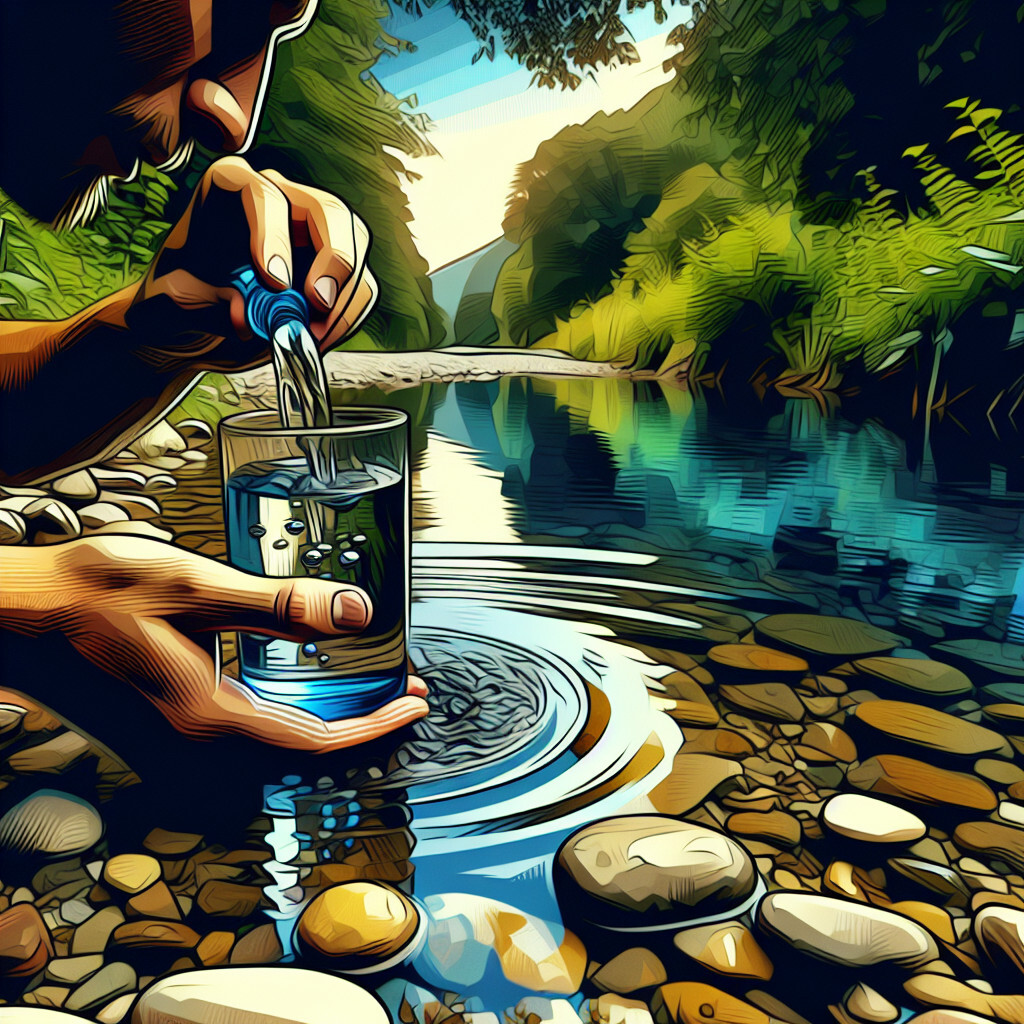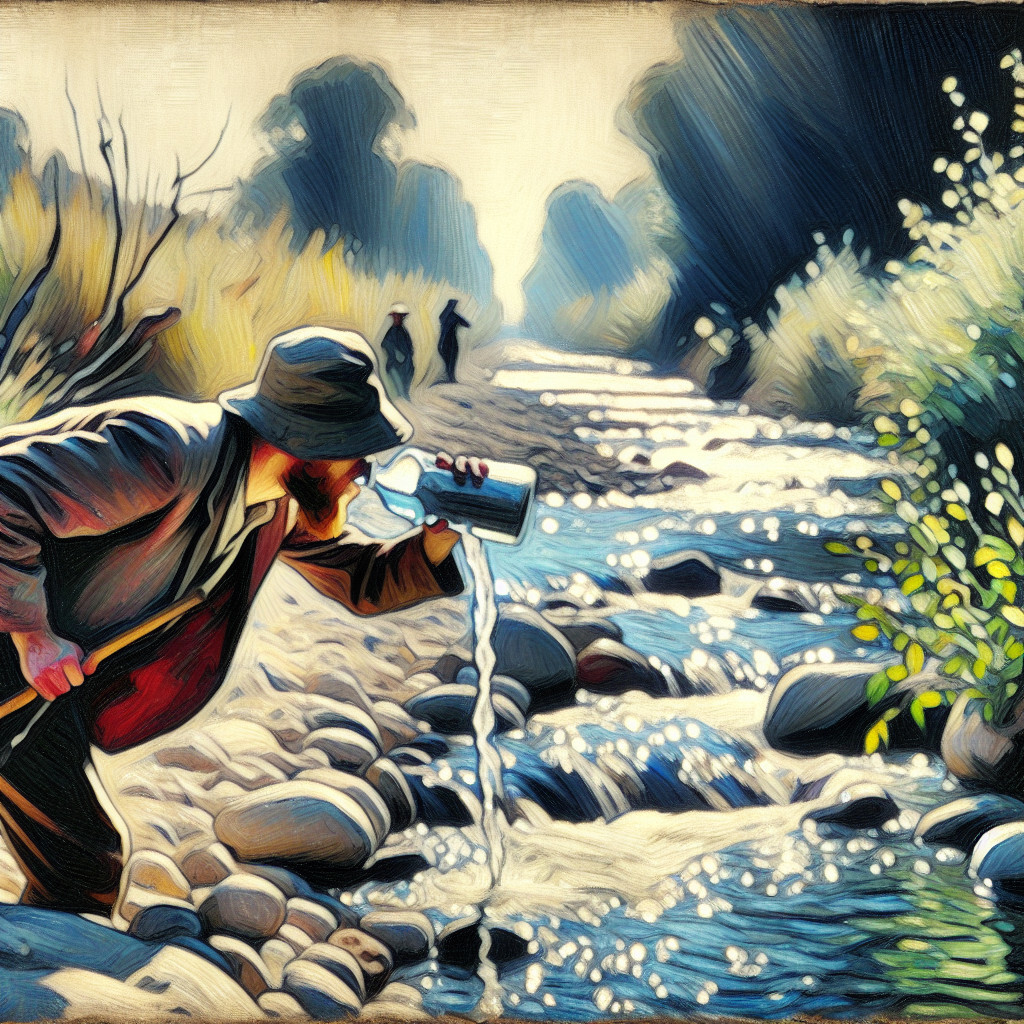-
Table of Contents
“Experience Nature’s Purity: Filtered Creek Water.”
Introduction

Drinking filtered creek water refers to the process of purifying water from natural streams or creeks to make it safe for consumption. This practice is often necessary in survival situations, outdoor adventures, or in areas where clean, potable water is not readily available. The filtration process removes harmful bacteria, parasites, and other contaminants, ensuring the water is safe to drink. Despite the source being natural, unfiltered creek water can carry diseases and harmful microorganisms, making filtration crucial.
Understanding the Health Benefits of Drinking Filtered Creek Water
Drinking filtered creek water is a practice that has been gaining popularity in recent years, particularly among outdoor enthusiasts and survivalists. This trend is not without merit, as filtered creek water can offer a range of health benefits, provided it is properly treated and filtered. However, it is essential to understand the potential risks and precautions necessary to ensure the water is safe for consumption.
Creek water, in its natural state, is a rich source of essential minerals such as calcium, magnesium, and potassium. These minerals are vital for various bodily functions, including bone health, muscle function, and maintaining a healthy blood pressure. Unlike processed bottled water, which often lacks these essential minerals, filtered creek water can provide a more natural and balanced mineral intake.
Moreover, filtered creek water is free from the chemicals often found in tap water. Chlorine, for instance, is commonly used in municipal water treatment to kill bacteria and other microorganisms. While effective at disinfecting water, chlorine can react with organic matter to form harmful by-products. Long-term exposure to these by-products has been linked to an increased risk of certain types of cancer. By drinking filtered creek water, you can avoid these potentially harmful chemicals.
However, it’s important to note that creek water, like any natural water source, can also contain harmful bacteria, viruses, and parasites. These microorganisms can cause a range of illnesses, from mild gastrointestinal upset to severe, life-threatening diseases. Therefore, it’s crucial to filter and treat creek water before drinking it.
Fortunately, there are many portable water filters on the market that can effectively remove these harmful microorganisms. These filters work by trapping the microorganisms in a fine mesh, preventing them from passing through and into the water you drink. Some filters also contain activated charcoal, which can absorb chemicals and improve the taste of the water.
In addition to filtering, it’s also recommended to treat creek water before drinking it. This can be done through boiling, which kills most types of harmful microorganisms, or by using water purification tablets or drops. These treatments contain chemicals that kill bacteria, viruses, and parasites, making the water safe to drink.
While drinking filtered creek water can offer health benefits, it’s important to remember that not all creek water is safe to drink, even after filtering and treatment. Creeks located near agricultural or industrial areas may contain harmful chemicals from runoff, which can’t be removed by standard filters or treatments. Therefore, it’s always best to source your water from a clean, unpolluted creek, far from potential sources of contamination.
In conclusion, drinking filtered creek water can provide a natural source of essential minerals and a way to avoid the chemicals often found in tap water. However, it’s crucial to filter and treat the water properly to remove harmful microorganisms. By taking these precautions, you can enjoy the health benefits of drinking filtered creek water while minimizing the potential risks.
The Process of Filtering Creek Water for Safe Drinking
Drinking filtered creek water is a practice that has been adopted by many outdoor enthusiasts, survivalists, and even some communities around the world. The process of filtering creek water for safe drinking is a fascinating one, involving a series of steps that ensure the water is free from harmful bacteria, viruses, and other contaminants.
The first step in the process is the collection of the creek water. It is crucial to select a spot where the water is flowing, as stagnant water is more likely to contain harmful microorganisms. The water should be clear and free from visible debris. If the water appears cloudy or contains visible particles, it may require pre-filtering using a cloth or a coffee filter to remove the larger impurities.
Once the water has been collected, the next step is the actual filtration process. There are several methods available for this, each with its own set of advantages and disadvantages. One of the most common methods is the use of a portable water filter. These devices are compact, lightweight, and easy to use, making them ideal for outdoor activities. They work by forcing the water through a series of fine membranes or filters that trap and remove bacteria, viruses, and other harmful substances.
Another popular method is the use of water purification tablets or drops. These chemical treatments work by killing bacteria and viruses in the water. While they are effective, they do not remove other contaminants such as heavy metals or chemicals. Therefore, they are often used in conjunction with a filter for maximum safety.
Boiling is another effective method of purifying creek water. By bringing the water to a rolling boil for at least one minute, most harmful organisms are killed. However, this method does not remove chemical contaminants and can be time-consuming and fuel-intensive, making it less suitable for some situations.
After the water has been filtered or treated, it is essential to store it properly to prevent recontamination. The water should be stored in a clean, sealed container and kept away from potential sources of contamination. If the water is to be stored for an extended period, additional disinfection may be necessary to ensure its safety.
It is important to note that while these methods can significantly reduce the risk of illness from drinking creek water, they are not foolproof. Some contaminants, such as certain viruses and chemicals, are difficult to remove completely. Therefore, it is always best to drink creek water only as a last resort and to seek out treated, potable water whenever possible.
In conclusion, the process of filtering creek water for safe drinking involves several steps, from collection to filtration to storage. Each step is crucial in ensuring the safety of the water and reducing the risk of illness. While drinking filtered creek water can be a viable option in certain situations, it is always best to prioritize drinking water that has been properly treated and is known to be safe.
Exploring the Environmental Impact of Drinking Filtered Creek Water
Drinking filtered creek water is a practice that has been gaining traction in recent years, particularly among outdoor enthusiasts and survivalists. This practice involves sourcing water directly from creeks and other natural water bodies, then filtering it to remove impurities and potential pathogens. While this may seem like a sustainable and environmentally friendly way to source drinking water, it is essential to consider the environmental impact of this practice.
The process of drinking filtered creek water begins with the collection of water from a natural source. This water is then passed through a filter, which removes impurities such as sediment, bacteria, and viruses. The filtered water is then safe to drink, providing a source of hydration that is both natural and readily available. This practice has been lauded for its potential to reduce reliance on bottled water, which is often packaged in single-use plastic bottles that contribute to environmental pollution.
However, the environmental impact of drinking filtered creek water is not entirely positive. One of the primary concerns is the potential for contamination of natural water sources. When individuals source water from creeks, they may inadvertently introduce pollutants into the water. These pollutants can come from a variety of sources, including the equipment used to collect and filter the water, as well as the individuals themselves. For example, if an individual uses a plastic container to collect water, microplastics may leach into the water and subsequently enter the creek when the water is returned.
Moreover, the filtration process itself can also have a negative environmental impact. Many water filters, particularly those designed for portable use, utilize disposable cartridges. These cartridges, once used, become waste that must be disposed of. If not properly managed, this waste can contribute to landfill overflow and environmental pollution.
Furthermore, the increased foot traffic to creeks and other natural water sources can lead to habitat disruption for local wildlife. The presence of humans can disturb animals, alter their behaviors, and potentially lead to declines in local wildlife populations. This is particularly concerning in areas where the local fauna is already under threat from other environmental pressures.
In addition, the practice of drinking filtered creek water can also contribute to the overuse of natural resources. While water is a renewable resource, it is not unlimited. The increased extraction of water from creeks can lead to lower water levels, which can in turn affect the local ecosystem. This is particularly problematic in areas that are already experiencing water scarcity due to factors such as climate change and overpopulation.
In conclusion, while drinking filtered creek water may seem like an environmentally friendly practice, it is not without its potential negative impacts. These include the potential for contamination of natural water sources, the generation of waste from the filtration process, habitat disruption for local wildlife, and the overuse of water resources. Therefore, it is crucial for individuals who choose to drink filtered creek water to do so responsibly, taking care to minimize their environmental impact and preserve the natural resources that we all depend on.
Comparing Filtered Creek Water to Tap and Bottled Water: A Comprehensive Guide
Drinking filtered creek water is a practice that has gained popularity in recent years, particularly among outdoor enthusiasts and survivalists. This trend has sparked a debate about the safety and quality of filtered creek water compared to more conventional sources like tap and bottled water. This article aims to provide a comprehensive guide to understanding the differences between these water sources.
The process of filtering creek water involves using a portable water filter to remove harmful bacteria, parasites, and other contaminants. This method is often used during camping or hiking trips when access to clean water is limited. However, it’s important to note that not all water filters are created equal. Some are more effective than others at removing certain types of contaminants. Therefore, it’s crucial to choose a high-quality water filter and use it correctly to ensure the safety of the filtered creek water.
On the other hand, tap water is the most readily available source of drinking water for most people. It’s regulated by the Environmental Protection Agency (EPA) in the United States, which sets standards for over 90 contaminants. Despite this, the quality of tap water can vary greatly depending on the location. For instance, in some areas, tap water may contain high levels of lead, chlorine, or other harmful substances. Therefore, many people choose to filter their tap water or buy bottled water to ensure its safety and improve its taste.
Bottled water is another popular choice for drinking water. It’s often perceived as being cleaner and safer than tap water. However, it’s worth noting that bottled water is not necessarily free from contaminants. In fact, some studies have found that bottled water can contain microplastics and other pollutants. Moreover, the production and disposal of plastic bottles contribute to environmental pollution, making bottled water a less sustainable option.
When comparing these three sources of water, it’s clear that each has its pros and cons. Filtered creek water can be a lifesaver in outdoor situations where no other water source is available. However, it requires a reliable water filter and proper usage to ensure its safety. Tap water is convenient and generally safe, but its quality can vary depending on the location. Bottled water is often seen as the safest option, but it can still contain contaminants and contributes to environmental issues.
In conclusion, the choice between filtered creek water, tap water, and bottled water often comes down to personal preference and circumstances. If you’re an outdoor enthusiast, investing in a high-quality water filter can allow you to safely drink from natural water sources. If you’re at home, tap water is usually a safe and convenient option, but you may choose to filter it or buy bottled water for added peace of mind. Regardless of the source, it’s important to ensure that your drinking water is clean and safe to protect your health.
Q&A
1. Question: Is it safe to drink filtered creek water?
Answer: While filtering can remove many contaminants, it may not remove all bacteria, viruses, or chemicals. Therefore, it’s not entirely safe to drink filtered creek water without further treatment like boiling or using purification tablets.
2. Question: What are the risks of drinking filtered creek water?
Answer: The risks include potential exposure to harmful bacteria, viruses, parasites, and chemicals that could cause illnesses such as giardiasis, cryptosporidiosis, and other waterborne diseases.
3. Question: What is the best method to make creek water safe for drinking?
Answer: The best method is a combination of filtration and disinfection. This can be achieved by using a portable water filter and then boiling the water or using water purification tablets.
4. Question: Can all water filters make creek water safe to drink?
Answer: Not all water filters can remove all types of contaminants. It’s important to use a filter that is designed to remove bacteria, viruses, and parasites commonly found in natural water sources. Even then, it’s recommended to use additional disinfection methods.
Conclusion
Drinking filtered creek water can be a viable option in survival situations, but it’s not entirely safe due to potential contaminants such as bacteria, viruses, and pollutants. Even with filtration, there’s still a risk of ingesting harmful substances. Therefore, it’s recommended to boil or use purification tablets in addition to filtration for maximum safety.






